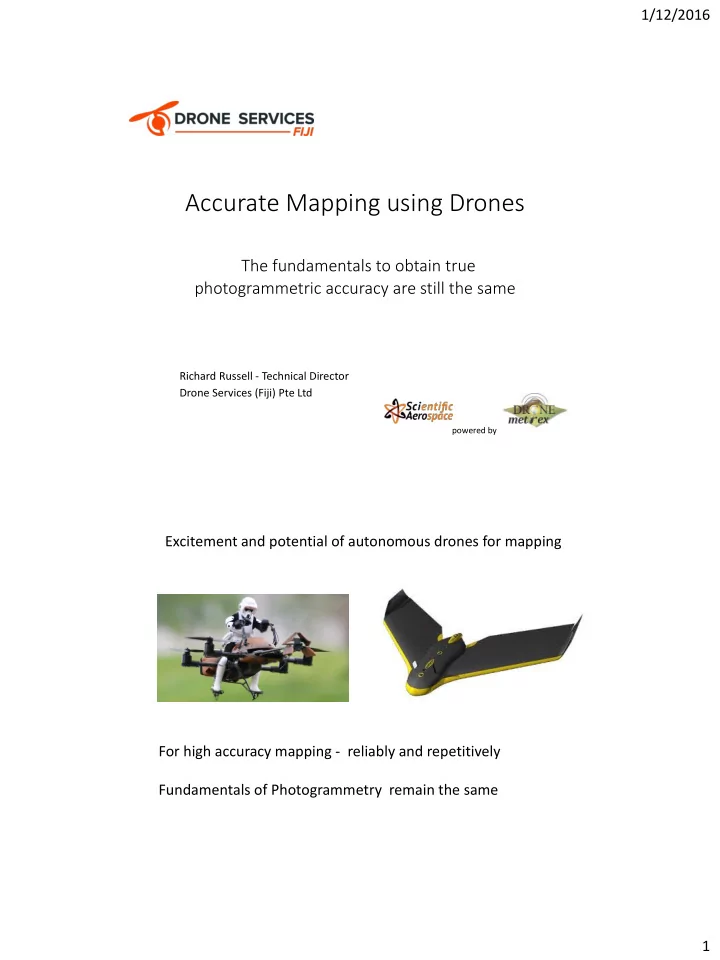

1/12/2016 Accurate Mapping using Drones The fundamentals to obtain true photogrammetric accuracy are still the same Richard Russell - Technical Director Drone Services (Fiji) Pte Ltd powered by Excitement and potential of autonomous drones for mapping For high accuracy mapping - reliably and repetitively Fundamentals of Photogrammetry remain the same 1
1/12/2016 Some definitions Accuracy: Proximity of measurement results to true values Precision: Reliable and repetitive mapping Accurate Drone Mapping system: achievable accuracies in the X, Y and Z (height) verifiable and repeatable Recognition, measurement and mathematical treatment of mapping system errors • Roll Ω , Pitch Φ , Yaw, Κ • Scaling • Approximation of parameters Goal of photogrammetry: accurate measurement of imagery by rigorous treatment of errors 2
1/12/2016 Physical Environment and Sensors • Aggressive environment Wind, turbulence, internal vibration • Tips, tilts, yaw, forward & lateral motion compensation • Flight planning and implementation • Digital v’s Commercial Off the Shelf (CTOS) Cameras • Camera fixed to airframe Errors are random, What we want unknown and significant 3
1/12/2016 Roll Ω , Pitch Φ , Yaw, Κ compensation Gyro-stabilised Active Gimbal Hardware and Software solutions to achieve accurate mapping • roll, pitch and yaw solved with the use of a Gyro-stabilised Active Mount (GAM) built into the drone • Frames are near-nadir and have almost no crab • Integrated with the Flight Management Software • Record remaining small amounts of Ω , Φ , Κ with the GAM • Results: images in nadir position with better than 1 degree of accuracy • Imagery is immediately available for human 3D stereo viewing • Reduction or elimination of angular image motion Dynamically Stabilised Active Mount 4
1/12/2016 Image with and without Gyro-Stabilised Active Mount Warped and skewed image without the GAM 5
1/12/2016 Cameras Small UAV payload weight & flight endurance dictate cameras • Digital cameras, small, light and cheap (but tragic for accurate photogrammetric mapping) • Photogrammetric Cameras - expensive and heavy • Commercial Off The Shelf (COTS) Digital cameras specify for the drone with Photogrammetric fundamentals 6
1/12/2016 Fundamentals to specify for the CTOS camera Largest Field of View (FOV) - Larger the FOV the greater the effective ground coverage • Large ground coverage = less flight runs to cover the same area of interest (AOI) • Less images to match and process • Increases the accuracy of the photogrammetry Larger Sensor and Pixel size • full frame sensor 36mm x 24mm, bigger image sensors = better quality photo’s Fundamentals to specify for the CTOS camera Shutter system, Focal plane v’s Leaf • Focal plane, curtain with a slit travels across the digital sensor, not suitable for photogrammetry • Leaf shutter 7
1/12/2016 Examples • Natural Colour 8
1/12/2016 Understanding the Digital Camera’s high dynamic range 14 bit digital image technology allows us to get more detail out of areas that are traditionally featureless 25 mm height accuracy Nadir camera position, with no crab angle Direct Geo-referencing PPK solution (no requirement for ground control) 9
1/12/2016 Summary • Drones systems designed from first principles as accurate Photogrammetric systems • Dynamic Stabilised Active Mounts • 20, 24, 36 Mp calibrated full-frame CTOS (Prosumer) camera sensors • Direct Georeferencing PPK system • 20mm horizontal (X & Y), 25 mm vertical (Z) accuracy powered by Acknowledgement Thomas Tadrowski Dronemetrex Pty Ltd powered by 10
1/12/2016 request a copy of the white paper from ri richard@droneserv rvicesfiji.com.fj powered by 11
Recommend
More recommend